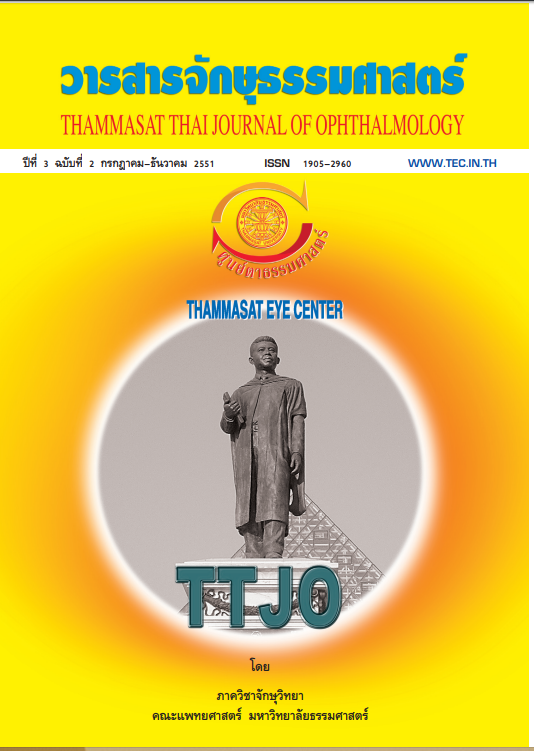ผลการประเมินความรุนแรงของโรคตาแห้งหลังให้การรักษาด้วยน้ำตาเทียบมชนิดไม่มีสารกันเสียกับยาหยอดตาไซโคลสปอรินทร์
Main Article Content
Abstract
วัตถุประสงค์: เพื่อประเมินความรุนแรงของโรคตาแห้งเปรียบเทียบเชิงคุณภาพของสุขภาพผิวเยื่อ บุตาถึงประสิทธิผลของน้ำตาเทียมชนิดไม่มีสารกันเสีย กับไซโคลสปอรินทร์ ในการรักษาโรคตาแห้ง
วิธีการศึกษา: เป็นการศึกษาเชิงสำรวจและพรรณนาแบบไปข้างหน้า มีแบบสอบถามประเมินความรุนแรงของโรคตาแห้งกับผู้ป่วยโรคตาแห้งประเภทผู้ป่วย นอก โรงพยาบาลธรรมศาสตร์เฉลิมพระเกียรติ กลุ่มทดลองและกลุ่มควบคุมเป็นกลุ่มเดียวกัน โดยที่ผู้ป่วยโรคตาแห้งได้รับการหยอดน้ำตาเทียมชนิดไม่มีสารกันเสียทั้งสอง ข้าง โดยใช้ตาข้างหนึ่งเป็นตาควบคุมและตาอีกข้างหนึ่งเป็นตาทดลองหยอดตาร่วมกับไซ โคลสปอรินทร์ ระยะเวลาในการศึกษา 6 เดือน
ผลการวิจัย: มีผู้ป่วยทั้งสิ้น 26 คน (52ตา) พบว่าไซโคลสปอรินทร์มีประสิทธิผลในการเพิ่มคุณภาพของผิวเยื่อบุตา (ocular surface) และลดปริมาณความถี่ของการหยอดยาน้ำตาเทียมอย่างมีนัยสำคัญ โดยมีอัตราความแตกต่างจากวันแรกรับของคะแนนความรุนแรงของโรคตาแห้งซึ่งวัด เป็น Modified Ocular Surface Disease Index (MOSDI)และปริมาณความถี่ของการหยอดยาตาน้ำตาเทียมเป็น -8.09 (1.02) และ -4.04 (0.61) ตามลำดับ เมื่อเทียบกับ -6.14 (1.00) และ -2.73 (0.53) ในกลุ่มน้ำตาเทียมชนิดไม่มีสารกันเสียเพียงอย่างเดียว (p < 0.05)
สรุปผลการศึกษา: ไซโคลสปอรินทร์ใช้ร่วมกับน้ำตาเทียมชนิดไม่มีสารกันเสีย มีคะแนนความรุนแรงของโรคตาแห้งในการรกษาโรคตาแห้งลดลง ผู้ป่วยมีคุณภาพของผิวเยื่อบุตาดีขึ้น และลดปริมาณความถี่ของการหยอดยาน้ำตาเทียม เมื ่อเทียบกับการรักษาโรคตาแห้งด้วยน้ำตาเทียมชนิดไมมีสารกันเสียเพียงอย่าง เดียว
Modified Ocular Surface Disease Index Measurement of Dysfunctional Tear Syndrome in Non preserved Artificial Tear and 0.05% Cyclosporine Emulsion
Objective: To study the Modified Ocular Surface Disease Index (MOSDI) and safety of 0.05% cyclosporine emulsion (0.05% CsA emulsion) in Dysfunctional Tear Syndrome (DTS). Design : Prospective experimental study
Methods: A total of 26 patients (52 eyes) with clinically diagnosed with DTS were randomized to receive either unpreserved artificial tear monotherapy in both eyes or 0.05% CsA emulsion twice-daily adjunctively in the other eye. Baseline clinical data of patients were collected on their first visit at pretreatment, after 1 week, 1, 3 and 6 months after treatment. At each study visit, dry eye symptoms were assessed using an interviewer-administered questionnaire; MOSDI score and frequency of non preserved artificial tear use per day.
Results: At 6 months, 0.05% CsA emulsion showed statistically significant improvement of mean (SEM) in MOSDI and decrease in frequency of non preserved artificial tear use per day from baseline, 0.05% CsA emulsion group was -8.09 (1.02) and -4.04 (0.61) respectively, compared with -6.14 (1.00) and -2.73 (0.53) in non preserved artificial group (p <0.05).
Conclusions: Concurrent 0.05% cyclosporine emulsion was safe and effective in the treatment of DTS. Significantly improved ocular symptoms (MOSDI) and decreased in frequency of non preserved artificial tear use per day.


